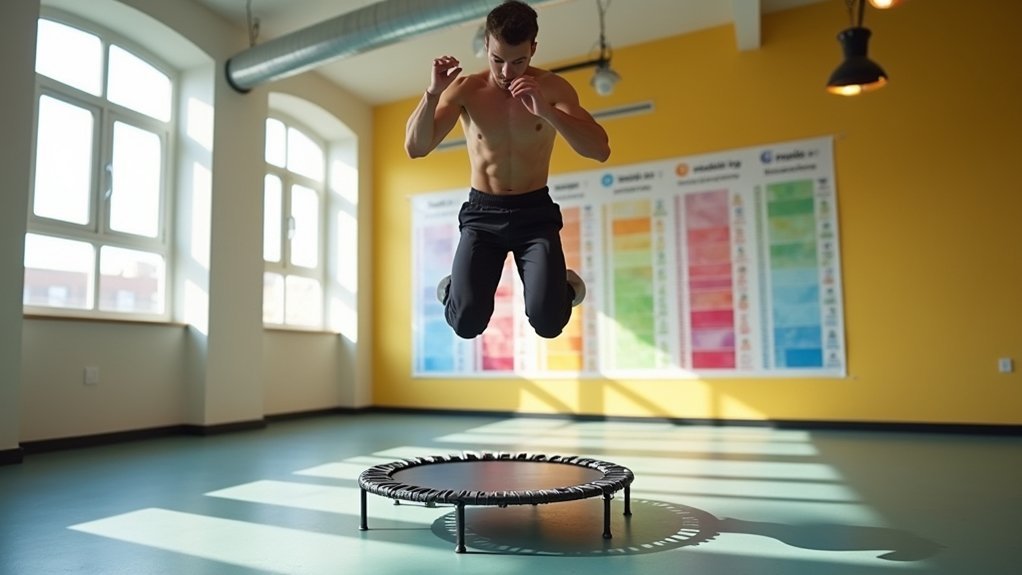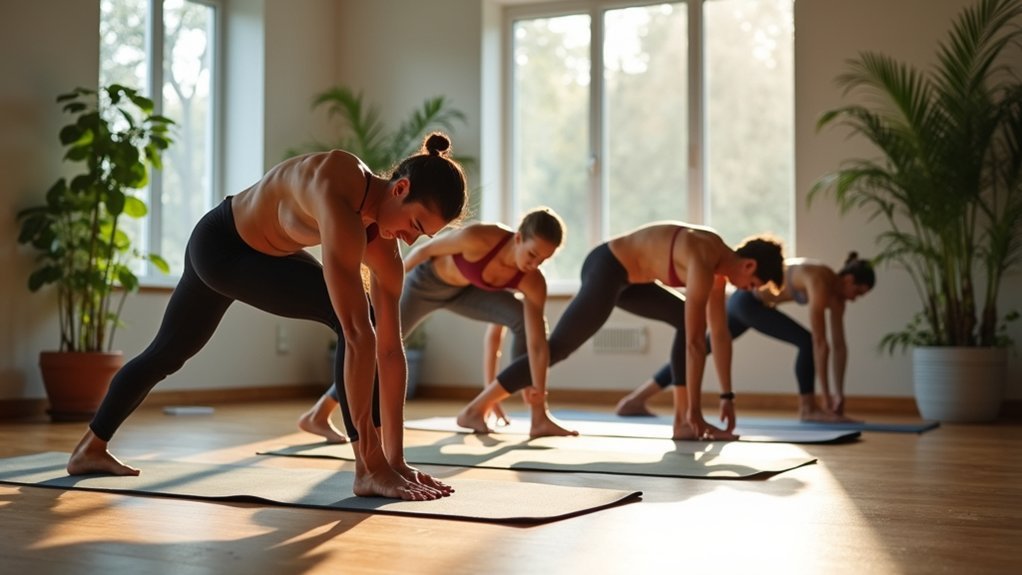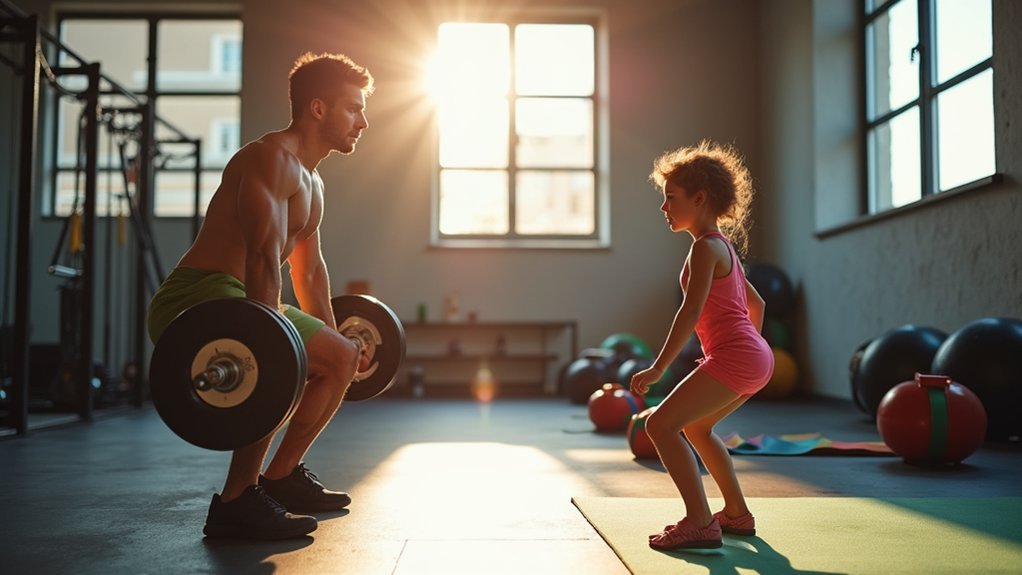Core stability mastery on a mini trampoline follows five essential steps: first, assess your current core strength through balance tests; then master fundamental rebounding techniques with proper alignment. Next, progress to dynamic exercises that engage multiple muscle groups simultaneously. Fourth, integrate multi-directional movements to challenge your stability systems. Finally, advance to power-based training with explosive movements for enhanced performance. These progressive steps build functional strength that translates to improved everyday movement and athletic ability.
Assess Your Core Stability on the Mini Trampoline

Why is a mini trampoline one of the most effective tools for evaluating core strength? Its unstable surface challenges your body in ways a stability ball can’t match, increasing core muscle engagement by up to 30%.
Start with gentle bouncing while maintaining upright posture—this immediately forces you to engage your core for balance. Progress to single-leg balances or knee lifts while bouncing to further test your core activation and identify weak spots.
When you bounce upright, your core engages naturally. Challenge yourself with single-leg work to reveal hidden weaknesses.
The trampoline enhances proprioception, revealing inefficient movement patterns you might miss on stable surfaces. Track your progress regularly; improved performance on the trampoline typically translates to better overall physical function.
This assessment method not only evaluates your current core stability but also strengthens it simultaneously.
Master Fundamental Rebounding Techniques
Once you’ve assessed your core stability, mastering proper rebounding technique becomes your foundation for progress.
Begin by establishing proper alignment—keeping your spine neutral, knees slightly bent, and hips centered protects the spine and maximizes core engagement.
As you bounce, focus on controlled breathing that synchronizes with your movements, amplifying core activation and enhancing your stability.
Keep your core muscles engaged throughout each movement, not just during the most challenging moments.
Start with basic bounces before gradually incorporating lateral movements and arm coordination.
This progression naturally strengthens your core muscles while building essential endurance.
Through consistent practice, you’ll develop muscle memory that improves your rebounding efficiency.
Remember that training the core isn’t just about power—it’s about creating a stable center from which all movements can flow seamlessly.
Progress to Dynamic Stability Exercises

After establishing your foundation with basic rebounding techniques, you’re ready to challenge your stability system through dynamic exercises. These movements engage multiple muscle groups simultaneously, taking your core strength to new levels.
Before attempting advanced exercises like Medicine Ball Slams or Cable Rotations, confirm you’ve mastered fundamental stabilization moves. This progression reduces injury risk and maximizes effectiveness.
When you incorporate dynamic stability exercises, maintain proper engagement of the core throughout each movement. Research shows these exercises greatly improve athletic performance by enhancing coordination and balance.
As you practice maintaining stability while in motion, your body develops functional strength that transfers to everyday activities and sports. The key is consistent progression—challenging your body under increasingly dynamic conditions while never compromising form.
Integrate Multi-Directional Movement Patterns
While basic stability exercises build a solid foundation, multi-directional movement patterns take your stability training to an entirely new dimension.
By incorporating lateral lunges and rotational exercises, you’ll enhance core stability through various planes of motion—critical for functional strength in everyday activities and sports.
Movement is never one-dimensional—neither should your stability training be.
Try the side plank with rotation to challenge your abdominal muscles while stabilizing your spine in different directions.
Medicine ball rotational throws further engage your core’s ability to resist and generate force. These movements activate both intervertebral and lumbo-pelvic stability systems simultaneously.
Your balance and neuromuscular coordination will improve as you practice these multi-directional exercises, reducing injury risk during dynamic movements.
The benefits extend beyond core endurance to include enhanced agility and responsiveness—essential qualities whether you’re an athlete or simply want to move better.
Advance to Power-Based Rebound Training

Multi-directional stability prepares your body for the next evolutionary step in core development: power-based rebound training. This advanced technique targets fast-twitch muscle fibers through explosive movements like medicine ball slams and plyometric jumps, notably enhancing your core strength and dynamic stability.
To maximize benefits, you’ll need unwavering focus on proper form and deliberate core engagement throughout each movement. Research shows this approach can boost your vertical jump by 10% while improving essential athletic performance metrics.
You’ll notice tangible improvements in reaction time and agility as you consistently incorporate power training into your routine. These enhancements transfer directly to sports performance and everyday activities, creating a powerful, responsive core that supports both explosive movements and maintains stability under pressure.
Frequently Asked Questions
What Is the Hardest Corepower Yoga Class?
The hardest CorePower Yoga class is C2, which challenges you with advanced poses in a heated room around 100°F. You’ll face demanding sequences requiring significant core strength, balance, and mental focus.
How to Train Core Stability?
Train your core stability by performing the drawing-in maneuver and abdominal bracing. Incorporate exercises like Side Plank and Pallof Press early in workouts. Practice consistently 2-3 times weekly while maintaining proper form throughout each movement.
What Are the Components of the Core Stability?
Your core stability includes several components: abdominal muscles (transversus abdominis, rectus abdominis), back muscles (erector spinae, multifidus), diaphragm, pelvic floor, and hip muscles. They work together to support your spine during movement.
How Can Core Stability Be Enhanced?
You’ll enhance core stability through regular planks and bird dog exercises, implementing breath awareness during workouts, following progressive training methods, getting assessments for personalized modifications, and maintaining consistent 2-3 weekly sessions.
In Summary
You’ve now mastered the path to core stability through rebounding. By progressing from basic assessment to power-based training, you’ve built a foundation that serves your everyday movements and athletic endeavors. Your strengthened core now responds instinctively to challenges, providing the stability you need. Continue your practice, mixing these five steps regularly, and you’ll maintain this newfound core power for years to come.





Leave a Reply